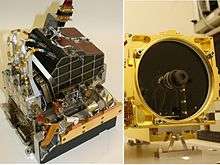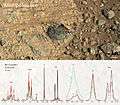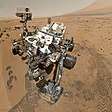Chemistry and Camera complex
Chemistry and Camera complex (ChemCam) is a suite of remote sensing instruments on Mars for the Curiosity rover. As the name implies, ChemCam is actually two different instruments combined as one: a laser-induced breakdown spectroscopy (LIBS) and a Remote Micro Imager (RMI) telescope. The purpose of the LIBS instrument is to provide elemental compositions of rock and soil, while the RMI will give ChemCam scientists high-resolution images of the sampling areas of the rocks and soil that LIBS targets.[1] The LIBS instrument can target a rock or soil sample from up to 7 m (23 ft) away, vaporizing a small amount of it with about 50 to 75 5-nanosecond pulses from a 1067 nm infrared laser and then observing the spectrum of the light emitted by the vaporized rock.


Overview
ChemCam has the ability to record up to 6,144 different wavelengths of ultraviolet, visible, and infrared light.[2] Detection of the ball of luminous plasma will be done in the visible, near-UV and near-infrared ranges, between 240 nm and 800 nm.[1] The first initial laser testing of the ChemCam by Curiosity on Mars was performed on a rock, N165 ("Coronation" rock), near Bradbury Landing on August 19, 2012.[3][4][5] The ChemCam team expects to take approximately one dozen compositional measurements of rocks per day.[6]
Using the same collection optics, the RMI provides context images of the LIBS analysis spots. The RMI resolves 1 mm (0.039 in) objects at 10 m (33 ft) distance, and has a field of view covering 20 cm (7.9 in) at that distance.[1] The ChemCam instrument suite was developed by the Los Alamos National Laboratory and the French CESR laboratory.[1][7][8] The flight model of the mast unit was delivered from the French CNES to Los Alamos National Laboratory.[9]
Images
 First target on Mars of the ChemCam laser analyzer on the Curiosity rover ("Coronation" rock, August 19, 2012).
First target on Mars of the ChemCam laser analyzer on the Curiosity rover ("Coronation" rock, August 19, 2012). First laser spectrum of chemical elements from ChemCam on Curiosity ("Coronation" rock, August 19, 2012).
First laser spectrum of chemical elements from ChemCam on Curiosity ("Coronation" rock, August 19, 2012). Target on Mars of the ChemCam laser analyzer on Curiosity (closeup) ("Ithaca" rock, October 30, 2013).
Target on Mars of the ChemCam laser analyzer on Curiosity (closeup) ("Ithaca" rock, October 30, 2013).



See also
References
- "MSL Science Corner: Chemistry & Camera (ChemCam)". NASA/JPL. Retrieved September 9, 2009.
- "Rover's Laser Instrument Zaps First Martian Rock". 2012. Archived from the original on 2012-08-21. Retrieved 2012-08-20.
- Webster, Guy; Agle, D.C. (August 19, 2012). "Mars Science Laboratory/Curiosity Mission Status Report". NASA. Retrieved September 3, 2012.
- Staff. "'Coronation' Rock on Mars". NASA. Retrieved September 3, 2012.
- Amos, Jonathan (August 17, 2012). "Nasa's Curiosity rover prepares to zap Martian rocks". BBC News. Retrieved September 3, 2012.
- "How Does ChemCam Work?". ChemCam Team. 2011. Retrieved January 12, 2017.
- Salle B.; Lacour J. L.; Mauchien P.; Fichet P.; Maurice S.; Manhes G. (2006). "Comparative study of different methodologies for quantitative rock analysis by Laser-Induced Breakdown Spectroscopy in a simulated Martian atmosphere" (PDF). Spectrochimica Acta Part B-Atomic Spectroscopy. 61 (3): 301–313. Bibcode:2006AcSpe..61..301S. doi:10.1016/j.sab.2006.02.003.
- Wiens R.C.; Maurice S. (2008). "Corrections and Clarifications, News of the Week". Science. 322 (5907): 1466. doi:10.1126/science.322.5907.1466a. PMC 1240923.
- ChemCam Status April, 2008 Archived 2013-11-09 at the Wayback Machine. Los Alamos National Laboratory.
External links
| Look up ChemCam in Wiktionary, the free dictionary. |

- Curiosity home page at NASA.gov
- How Does ChemCam Work? at MSL-ChemCam.com
